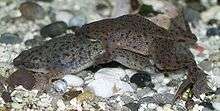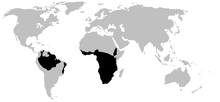Pipidae
| Pipidae Temporal range: 145–0 Ma Lower Cretaceous to recent | |
|---|---|
 | |
| African dwarf frog | |
| Scientific classification | |
| Kingdom: | Animalia |
| Phylum: | Chordata |
| Class: | Amphibia |
| Subclass: | Lissamphibia |
| Superorder: | Batrachia |
| Order: | Anura |
| Suborder: | Mesobatrachia |
| Family: | Pipidae Gray, 1825 |
 | |
| Distribution of Pipidae (in black). | |
The Pipidae are a family of primitive, tongueless frogs. The 41 species in the family Pipidae are found in tropical South America (genus Pipa) and sub-Saharan Africa (the three other genera).
These frogs are exclusively aquatic and have numerous morphological modifications befitting their habitat. For example, the feet are completely webbed, the body is flattened, and a lateral line system is present.[1] In addition, pipids possess highly modified ears for producing and receiving sound underwater. They lack a tongue or vocal cords, instead having bony rods in the larynx that help produce sound. They range from 4 to 19 cm (1.6 to 7.5 in) in body length.[2]
The fossil record for pipids is relatively good, with 12 extinct species known. Six of these are placed in the extant genus Xenopus, the remainder in extinct genera. These fossils are known from Africa, South America, and the Middle East back to the Lower Cretaceous.[2]
Genera
Family Pipidae Gray, 1825 [3]
- Hymenochirus Boulenger, 1896 - dwarf clawed frogs (4 species)
- Pipa Laurenti, 1768 - Surinam toads (7 species)
- Pseudhymenochirus Chabanaud, 1920- Merlin's dwarf gray frog or Merlin's clawed frog (1 species)
- Xenopus Wagler, 1827 - clawed frogs (29 species) [4]
References
- ↑ "AmphibiaWeb: Pipidae". Berkeley, California: AmphibiaWeb. Retrieved 2009-10-25.
- 1 2 Zweifel, Richard G. (1998). Cogger, H.G.; Zweifel, R.G., eds. Encyclopedia of Reptiles and Amphibians. San Diego: Academic Press. pp. 86–87. ISBN 0-12-178560-2.
- ↑ Pipidae at the Amphibian Species of the World 6.0
- ↑ Evans et al. (2015), Genetics, morphology, advertisement calls, and historical records distinguish six new polyploid species of African Clawed Frog(Xenopus, Pipidae) from West and Central Africa., PLoS One 10(12): e0142823: 1–51.
- Gissi, Carmela; Diego San Mauro; Graziano Pesole; Rafael Zardoya (February 2006). "Mitochondrial phylogeny of Anura (Amphibia): A case study of congruent phylogenetic reconstruction using amino acid and nucleotide characters". Gene. 366 (2): 228–237. PMID 16307849. doi:10.1016/j.gene.2005.07.034.
- Roelants, Kim; Franky Bossuyt (February 2005). "Archaeobatrachian paraphyly and pangaean diversification of crown-group frogs". Systematic Biology. 54 (1): 111–126. PMID 15805014. doi:10.1080/10635150590905894.
- San Mauro, Diego; Miguel Vences; Marina Alcobendas; Rafael Zardoya; Axel Meyer (May 2005). "Initial diversification of living amphibians predated the breakup of Pangaea". American Naturalist. 165 (5): 590–599. PMID 15795855. doi:10.1086/429523.
External links
![]() Data related to Pipidae at Wikispecies
Data related to Pipidae at Wikispecies
![]() Media related to Pipidae at Wikimedia Commons
Media related to Pipidae at Wikimedia Commons